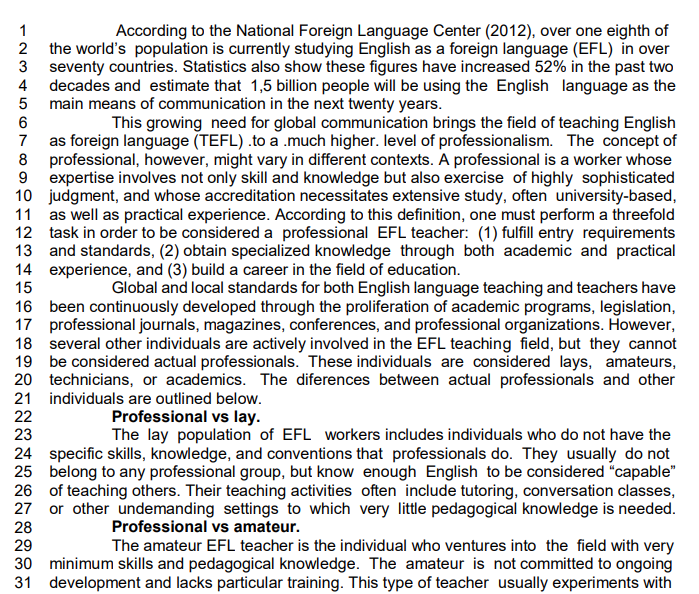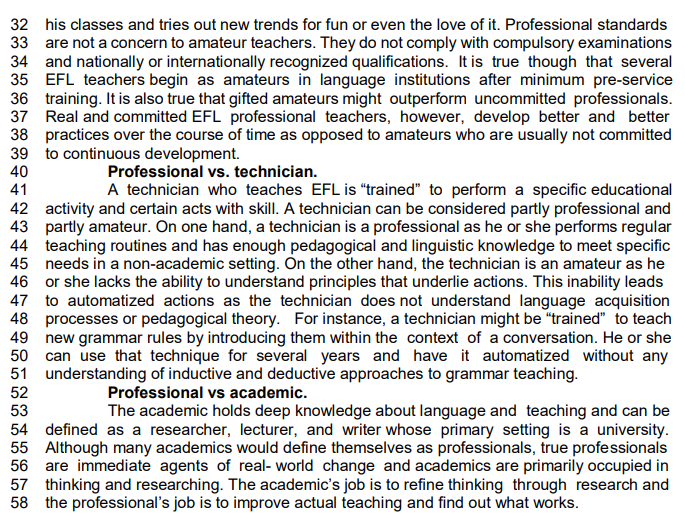Questões de Concurso
Comentadas sobre aspectos linguísticos | linguistic aspects em inglês
Foram encontradas 616 questões
Magi Richani is the founder of San Francisco-based Nobell Foods, a startup company developing a new kind of cheese made from soybeans. She says plant-based cheese not only accommodates people who can’t consume dairy, but it also could be key to more sustainable food production worldwide. “The reality is that when you raise an animal for food, it’s not just the animals, you are actually growing crops, you are clearing land, and you’re raising the animal for years so it builds biomass,” Richani explained. “It’s an extremely inefficient supply chain.”
Nobell is particularly focused on creating plant-based casein, which is a protein produced when a cow gives birth and is present in the milk for its offspring. It is the ingredient that gives dairy cheese its unique stretchy texture. If Nobell is able to go to market and have the kind of impact it’s hoping to, then plant-based cheese could help us stretch toward a more sustainable future.
Internet: <newsweek.com> (adapted).
Based on the ideas presented in the previous text as well as its linguistic aspects, judge the following item.
The words “stretch” (last sentence of the text) and “stretchy” (second sentence of the last paragraph), although similar, convey different meanings: “stretchy” refers to a concrete sensation, whereas “stretch” is used in a metaphorical abstract way.
Considering the lexical-grammatical aspects of the English language, evaluate the following item.
The sentence "less people attended the event" is grammatically correct because "less" is commonly used with countable nouns.
Considering the lexical-grammatical aspects of the English language, evaluate the following item.
The word "advice" is countable, so it's correct to say "an advice" when referring to a piece of advice.
“The professional of Teaching English as a Foreign Language”
Author: Anderson Francisco Guimarães Maia


Em uma atividade de sala, a professora pediu aos alunos que marcassem em suas agendas seus planos para a semana seguinte. Em seguida, eles deveriam sentar-se com um colega e simular um diálogo. Para realizar a atividade, ela escreveu na lousa o seguinte diálogo, a partir do qual os alunos deveriam usar corretamente um repertório linguístico aprendido para preencher a lacuna.
Aluno A: What __________ (do) on Monday/Tuesday/Wednesday…?
Aluno B: I ____________ (play soccer/go dancing/do my homework…) on Monday/Tuesday/Wednesday…
Para que os alunos sejam bem-sucedidos nessa atividade, é preciso que eles saibam usar corretamente qual tempo verbal?

Multidict.net. Advertising language. Multidict.net, 2024. Disponível em: https://multidict.net/clilstore/page.php?id=5243. Acesso em: 12 jul. 2024.
Uma das formas de identificar a função social de um texto é a partir dos recursos linguísticos usados. O anúncio publicitário acima tem a função social de induzir o leitor a ter um certo comportamento, que é alcançada, também, pelo uso de
Atenção! Leia o poema a seguir para responder à questão.
Twinkle, Twinkle, Little Star
Twinkle, twinkle, little star,
How I wonder what you are!
Up above the world so high,
Like a diamond in the sky.
When the blazing sun is gone,
When he nothing shines upon,
Then you show your little light,
Twinkle, twinkle, all the night.
Then the traveler in the dark
Thanks you for your tiny spark,
How could he see where to go,
If you did not twinkle so?
In the dark blue sky you keep,
Often through my curtains peep
For you never shut your eye,
Till the sun is in the sky.
As your bright and tiny spark
Lights the traveler in the dark,
Though I know not what you are,
Twinkle, twinkle, little star.
TAYLOR, Jane. Twinkle, Twinkle, Little Star. Disponível em: https://www.classicalmusic.com/articles/what-are-the-lyrics-to-twinkle-twinkle-little-star. Acesso em: 11 jul. 2024. Adaptado.
Group 1 would- could-took-crook-food-facebook-push-put
Group 2 drawer-door-explore-dinosaur-before-folklore-your-more
The Orality axis in the teaching of English addresses only in-person oral practices, excluding those that occur without face-to-face contact.
Regarding English grammar, judge the following item.
In English, the use of double negatives is generally
considered grammatically incorrect and non-standard in
formal writing and speech, but it is acceptable and
commonly used in some dialects and informal contexts to
emphasize a negative meaning.
Responsible state fiscal policy requires more than just balancing the current year’s budget. It must also include ensuring that the budget is on a sustainable path. Otherwise, policymakers cannot have the lasting impact they hope for. This risk is especially high in the aftermath of the COVID-19 pandemic. Record budget surpluses, driven largely by federal pandemic aid, empowered states to adopt historically large tax cuts and spending increases from 2021 to 2023.
State leaders must be able to assess whether their decisions will be affordable over the long term or will jeopardize their ability to solve state problems or even sustain programs and services in the future. Unfortunately, the nature of state budget processes discourages such long-term thinking. State policymakers devote much of their time to developing, enacting, and implementing annual or biennial budgets, a prime opportunity to achieve immediate policy goals.
One key strategy for changing this short-term focus is for states to use long-term budget assessments and budget stress tests to regularly measure risks, anticipate potential shortfalls, and identify ways to address impending challenges. Long-term budget assessments project revenue and spending several years into the future, and stress tests estimate the size of temporary budget shortfalls that would result from recessions or other economic events and gauge whether states are prepared for these events.
Internet: <https://www.pewtrusts.org> (adapted).
Considering the ideas conveyed in the previous text, as well as its linguistic aspects, judge the following item.
Without harming the meaning and the correctness of the text,
the word “ensuring” (second sentence of the text) could be
correctly replaced with to make sure.
( )Written English is more complex grammatically than spoken English, with longer and more complex sentences, fewer contractions, and more subordinate clauses.
( ) Spoken English is more likely to be face-to-face communication, while written English is more likely to be communication through the written word.
( ) Spoken English is more fixed and stable than written English, which is more fleeting.
( ) Spoken English is usually more organized and carefully formulated than written English.
( ) Written English is typically more structured and forms a monologue rather than a dialogue, while spoken English is more likely to be a dialogue.
( ) Written English communicates across time and space for as long as the medium exists and the language is understood. Spoken English is more immediate.
( ) Spoken English normally uses a generally acceptable standard variety of the language, whereas written English may sometimes be in a regional or other limited-context dialect.
( ) In Spoken English, the content is presented much more densely. In written English, the information is “diluted” and conveyed through many more words: there are a lot of repetitions, glosses, “fillers”, producing a text is noticeably longer and with more redundant passages.
( A ) GRAMMAR-TRANSLATION METHOD ( B ) DIRECT METHOD ( C ) ORAL APPROACH ( D) AUDIOLINGUALISM METHOD
( ) Grammatical rules are not presented formally and the texts used for reading and writing activities are no longer literary since this method is based on certain principles, such as: selection, gradation and presentation.
( ) Learning is associated with syntactic, morphological and phonological structures which are learned from a system of stimulus, response and reinforcement.
( ) In this method, the writing skill is also developed, but not with a communicative purpose.
( ) Adopting the monolingual principle, this method involves the use of objects, gestures and images to explain the meanings of words, since the students' native language is prohibited from being used.
( ) Language learning would be associated with the formation of readers and the intellectual development of students.
( ) This method involves automatic correction and immediate assessment of students' mistakes by teachers in order to prevent the students from forming or acquiring bad habits and behaviors during the learning process.
( ) As a theoretical systematization of foreign language teaching, its objective would be the development of students' oral skills as the vocabulary and grammatical structures they have learned would be controlled in terms of frequency of occurrence.
( ) In this method, learning must be directly connected to the target language without going through the process of translation into the students' native language.
( ) The language to be taught is the spoken language and the new elements of the language are practiced situationally as the grammatical items are proposed gradually, that is, from the simplest to the most complex forms.
( ) In this method, language is both seen and considered as a behavior, for it is a means of oral communication.
Brazilian Portuguese learners of English tend to mispronounce and misperceive ‘final s’ in plural forms (nouns) and third person singular forms (in the present simple tense) as well as ‘final ed’ in simple past forms of regular verbs. Another common difficulty is choosing between “a” or “an”. In fact, there are simple phonological rules that can help learners overcome such difficulties. Mark (T) for the true statements and (F) for the false ones.
( ) The words moved, laughed, played, and rained have the same final sound.
( ) The words moved, laughed, hated, and shaked have two syllables.
( ) Considering the use of the indefinite article (a, an), it is correct to say: a car, a house, a dog, a one-eyed man, a university, an umbrella, and, an apple.
( ) The words cats, umbrellas, candles, and birds have the same final sound.
( ) The words books, chiefs, tops, and fakes have the same final sound.
Mark the alternative which contains the CORRECT sequence from the first to the last propositions.
Concerning Bilingualism, analyze the following statements (Gleason, J. B. e Ratner, N. B. The Development of Language. Pearson: Boston, 2009):
I. When a speaker gains a second language while retaining a first language, the process is called additive language. Often, the acquisition of the second language is seen as an asset, as enhancing the prestige and social and economic prowess of the speaker.
II. Subtractive bilingualism refers to the loss of fluency in one’s native language that occurs when acquiring a second language.
III. Being younger is an advantage in terms of the rate of acquisition, as younger learners acquire a second language more rapidly than older learners in untutored settings.
IV. The acquisition of a second language could occur in submersion settings in which the person is surrounded by native speakers of that second language, or in immersion settings, in which the person and other people received instruction in that second language only.
V. Children growing up learning two or more languages simultaneously can do so without difficulty and in much the same way as do monolingual children.
Check the alternative that presents the number of the CORRECT statements: